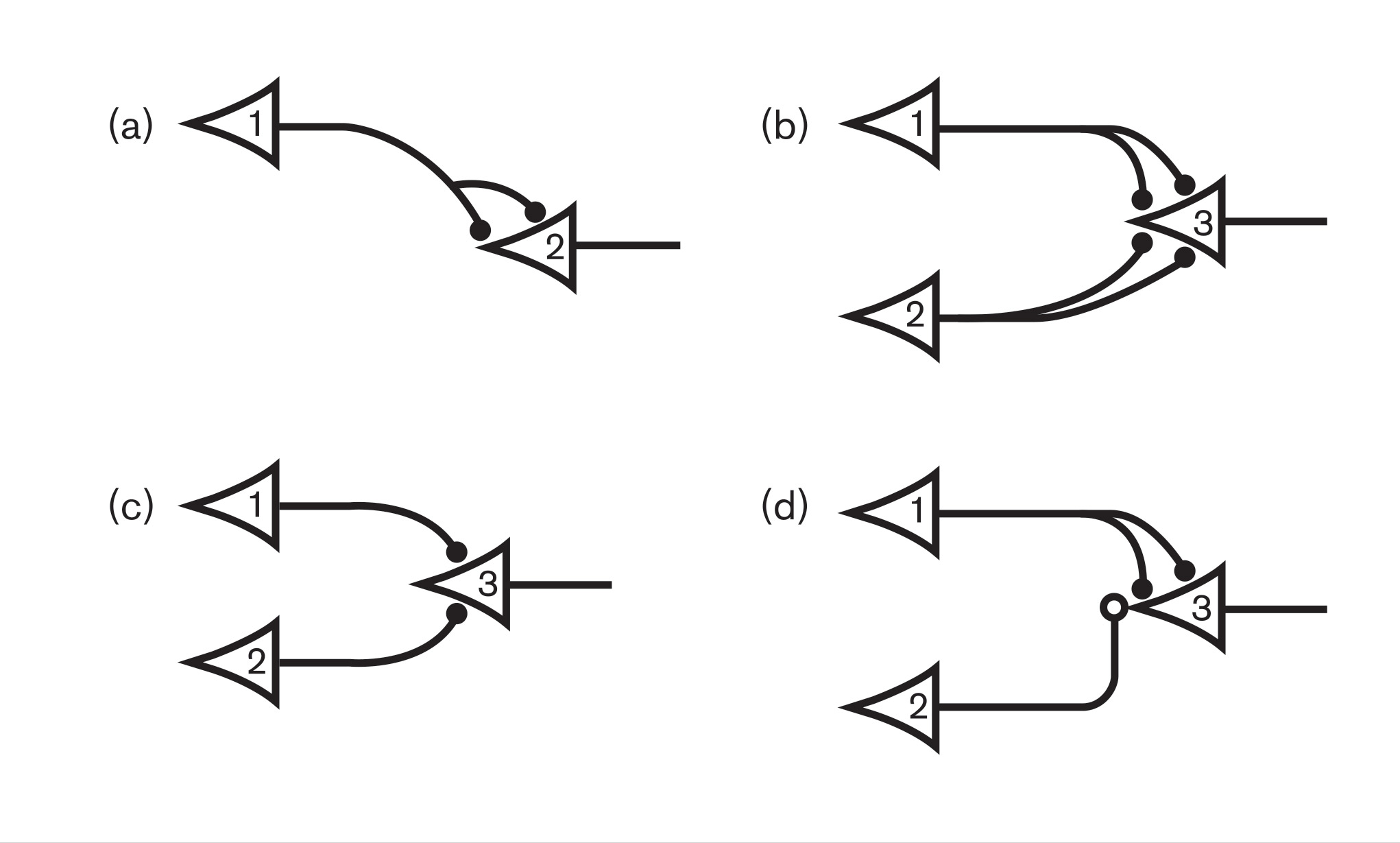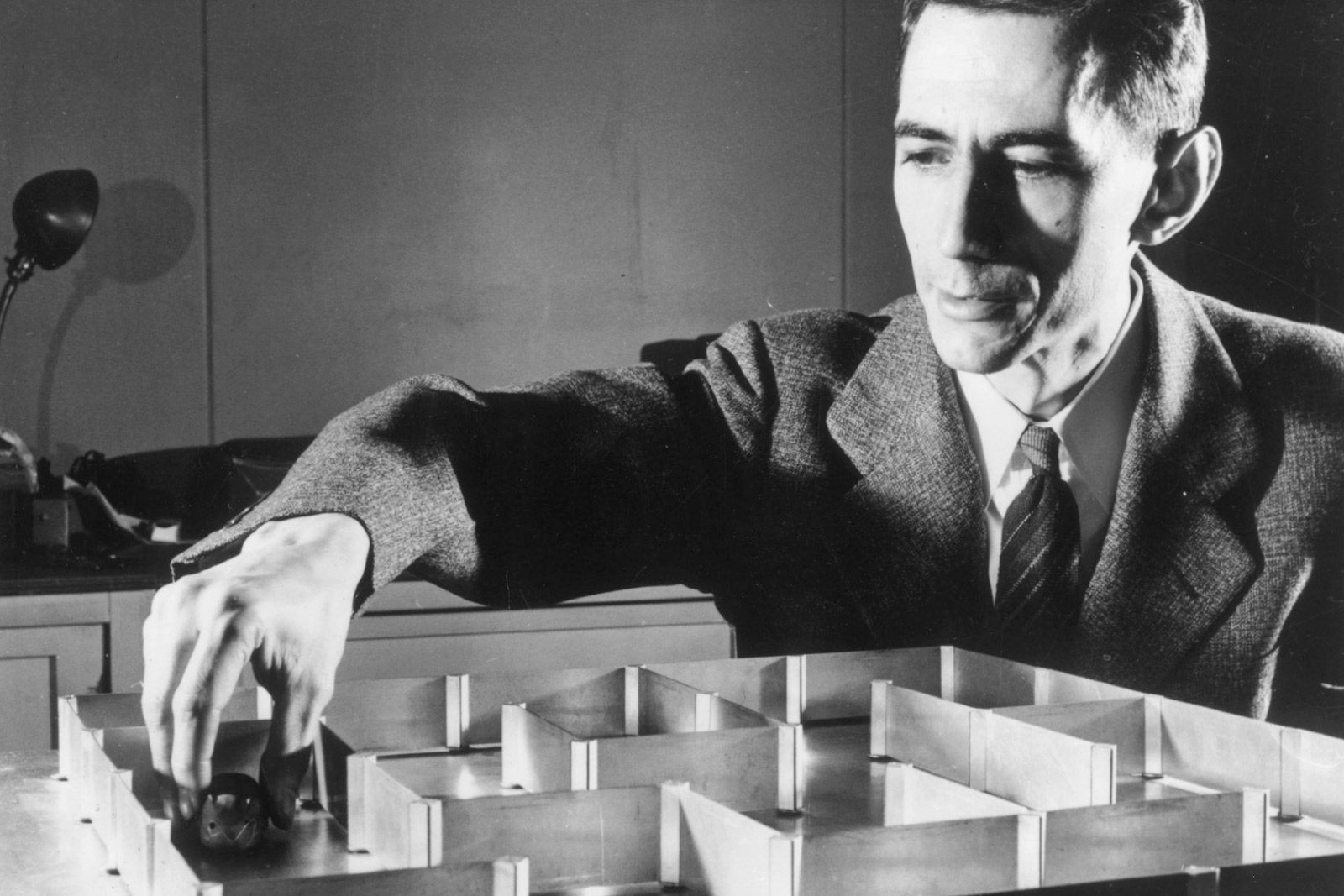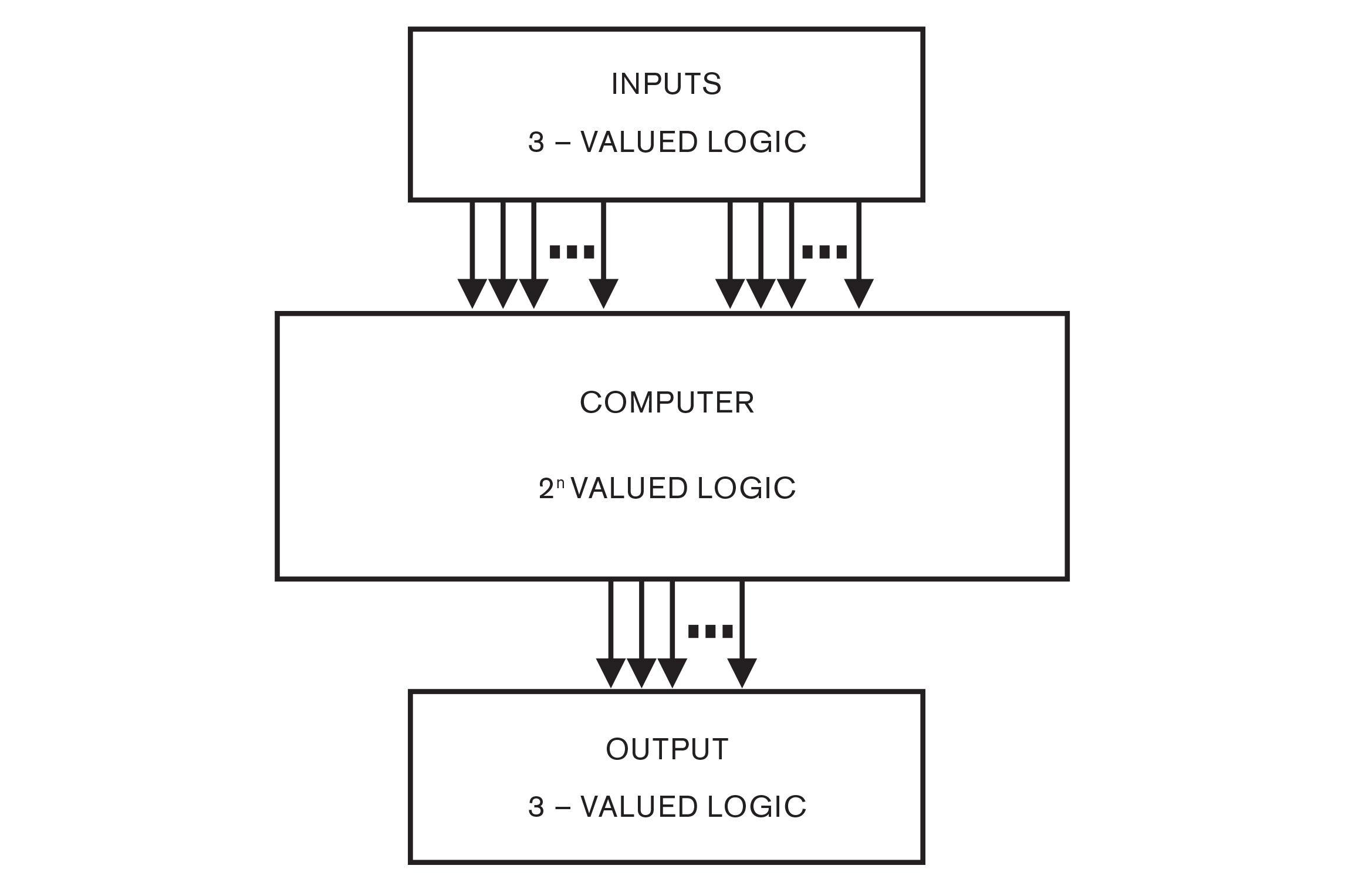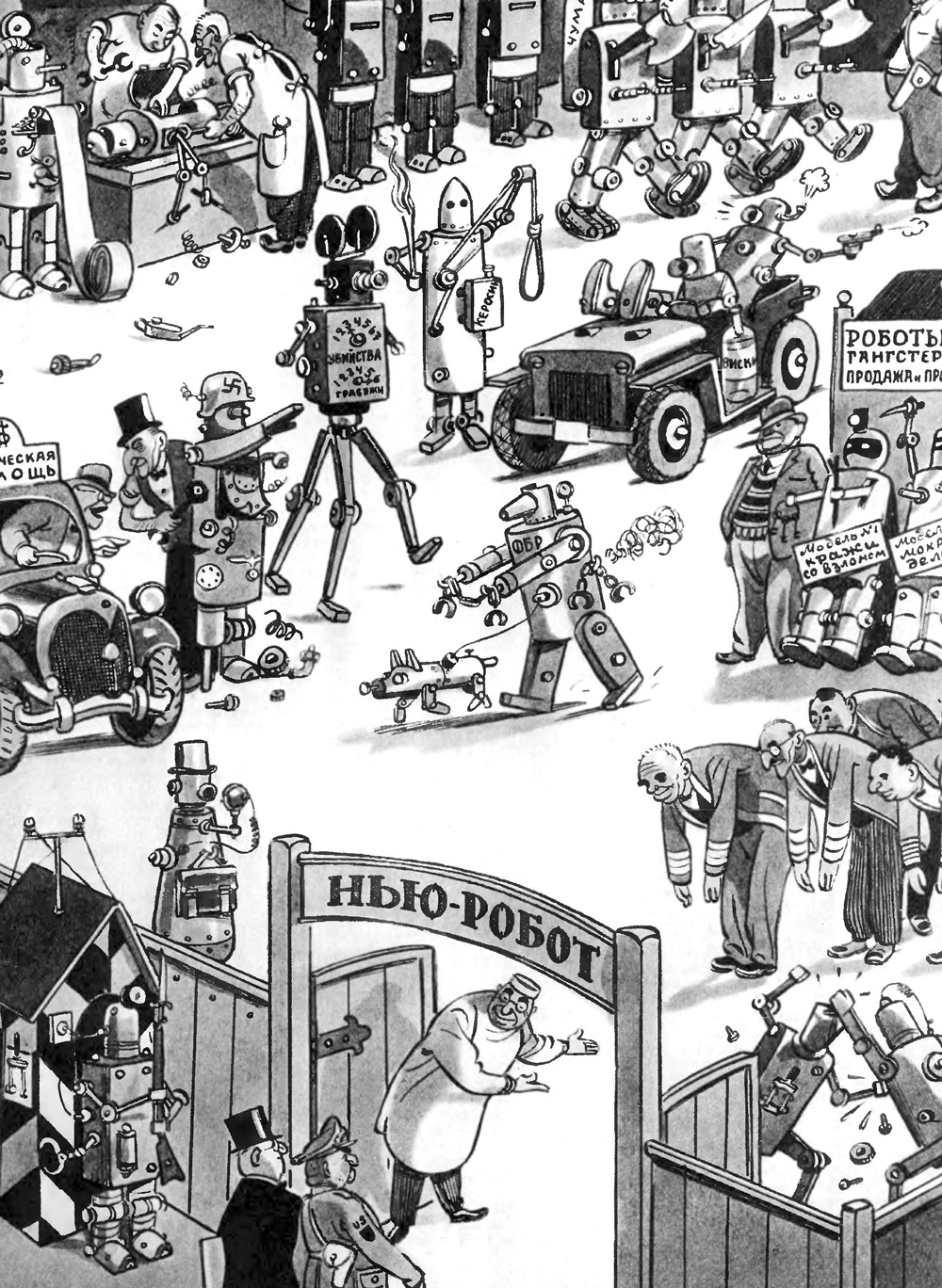Hegel 2.0
The imaginary history of ternary computing
Leif Weatherby
McCulloch himself had contributed to the “theory of automata,” which invented gadgets and formulas, some—like Ross Ashby’s “homeostat” or Claude Shannon’s labyrinth-traversing “mouse”—passed around at conferences for show-and-tell, some given only in mathematics at once esoteric and brazenly applied to animals, machines, and cognition. McCulloch had invented a formal automaton called a “nervous net.” The nets were composed of theoretical synapses—on/off switches, binary neurons—that could encode Boolean logic. They directly influenced John von Neumann—who also participated in the early cybernetics movement—in his design of modern computer architecture. They are also the basis for the current explosion of so-called “machine learning,” in which the nets are exposed to vast amounts of data and “learn” to recognize patterns—often patterns humans can’t see on their own.[2] With the major platform corporations investing heavily in this field and paying professional-athlete level salaries, the computer and the algorithm are set to take new steps into a digital unknown. The hardware and the learning—global infrastructure’s new core—is increasingly dependent on McCulloch’s legacy.

If McCulloch had gone to Moscow, it’s possible he would have seen, among other computers, Nikolai Brusentsov’s SETUN, named for a river near his institute. Brusentsov had designed the machine in 1958, using a magnetic drum for memory storage, and reducing its commands to as few as twenty-four. He claimed, in bombastic terms, that the machine was vastly more energy-efficient, more “natural” to use, and much cheaper than its competitors. This was because it traded not in binary digits—bits—but in “trits.” It was the first, and in many ways the only, computer based on ternary logic. The notion was that the 1s and 0s would be joined by a third term, -1, to balance the system numerically. The on/off switches were to have two different “on” settings. McCulloch was slowly pushing automata theory in a similar direction, one that unmoored not only computing but logic from binary, or Aristotelian, codes, and pushed it into stranger—and as we will see, Hegelian—waters. Until his death in 1969, McCulloch remained a committed Cold Warrior, so he remained at home, where there was plenty to do.
Still, he took the time to write an extensive philosophical rejection of the invitation, surveying the burgeoning field of Soviet cybernetics. The movement had gained international fame after Wiener’s founding document, the 1948 book Cybernetics: Communication and Control in the Animal and the Machine, became an improbable bestseller. Soviet scientists initially rejected the American discipline as “bourgeois” pseudoscience, but, as Slava Gerovitch and Benjamin Peters have shown, came to see the new science as a crucial weapon for any society to possess as the arms and space race crescendoed through the 1960s.[3] Soviet cybernetics was part of Khruschev’s “thaw” after Stalin’s death in 1953. But it still had to be measured against the ideological standard of Marxism-Leninism, so the stakes were always philosophical and political at once. Wiener had claimed, in high style, that “information is information, not matter or energy. No materialism which does not admit this can survive at the present day.”[4] The Soviet cyberneticians ran with this formulation, casting Wiener, as Peters puts it, “as a sort of foreign prophet announcing a dialectical materialist science of information science.”[5] To adopt Wiener was to declare the dialectic two-sided, to allow “information” to be its own historical instance. It was an imperfect theoretical marriage at best. McCulloch, who modestly claimed to have read “only a couple thousand pages” of their work, saw all of this, and tried to give this unfolding history another philosophical lineage.[6]

Surveying the history of Marxist epistemology—and tracing it back to debates in German Idealism—McCulloch referred back to his neural nets and the new digital machines. The problem was that the Russians refused to consider the possibility that machines could think:
You may remember that, in 1943, Pitts and I showed that an appropriate net of over-simplified neurons could compute any number a Turing machine could compute, which entails the same for conclusions. This was too much for Russian orthodoxy. I was anathematized, and Cybernetics stigmatized as bourgeois, idealistic metaphysics. About 1957 this attitude began to change, with mathematicians taking the lead, declaring Cybernetics was a powerful tool in the control of material systems. By about 1959 they began to get going and two years ago had eight institutes of Cybernetics underway. But there was, and is, an outcry that no machine can ever think. Thinking is dialectical and hence a prerogation of man due to his historical development as a social structure enjoying language! In short, it is all right for man’s physics to enjoy, and evolve, a dialectical development from the days of Newton to Einstein, but machines are excluded from this development. They must forever remains tools of man, and can do nothing that he has not told them to do. This is in flat contradiction to the whole development of self-organizing systems, teaching machines that learn, self-improving game-playing devices that beat their inventors, etc… They have plenty of brilliant youngsters and, if they want to, they can supply them with everything they need from computors [sic], living things, and books, including ours. I think they will. So I see no reason for me to go to Moscow. I have more important things to do here for science.[7]
McCulloch wanted to exit what he called the “blind alley” of dualistic thinking about cognition in general, opening a path to a cybernetic metaphysics that would reconsider the foundational questions of German Idealism. He usually preferred Kant to Hegel—in fact, while the whole movement was buzzing about Leibniz, Hegel was largely absent—but he was willing to use the latter against Marxism-Leninism, arguing that dualism about humans and machines wasn’t much better than dualism about mind and world. He was pointing—as he did throughout his career—beyond the binary. The Soviets, in other words, were defending a Marxist humanism. McCulloch, for his part, wanted what we might call a Hegelian posthumanism.[8]
SETUN made a strong impression on the Americans during first “thaw” visits of computer scientists to Moscow in 1958–1959, sparking a short-lived cottage industry of publications about the potential for non-binary computing, as Francis Hunger has extensively documented.[9] In the early 1970s, a renewed attempt was made at the State University of New York at Buffalo, resulting in the TERNAC, an emulation of a ternary computing system written in the early coding language FORTRAN and run on a Burroughs B 1700 (the company was started by William S.’s grandfather), a binary hardware system. The technical promise of the ternary system remained speculative except in software. It turned out that even SETUN—the only machine in which ternary was meant to be implemented in hardware—itself hadn’t exploited the alleged energy advantage: lacking a way to create an actual switch with two values encoded in one setting, Brusentsov had used two separate gates. In the second gate, one value was never employed, wasting more potential than the mathematical design promised to deliver in surplus.[10] Ternary computing, in other words, has always been emulation rather than implementation—its history is in large part imaginary.

The factories only produced about fifty SETUN computers, and its existence was threatened almost from the beginning. Brusentsov complained bitterly that the promise of his more “natural” computer—easier to use, cheaper to make, more energy-efficient—was eclipsed by bureaucrats, who in 1965 ordered production stopped on all SETUN machines. The Soviet Union was on the way to adopting international IBM-360 series programming standards, and East Germany would soon promulgate the so-called ESER (Einheitliches System Elektronischer Rechentechnik, or, Unified System of Electronic Computing Technologies). The final decision came in 1970, and the SETUN project shut down. Hope for ternary hardware has, to my knowledge, remained elusive.[11] International standardization, and now generations of commercialization, prevented and continue to embargo design behind a wall of “innovation” that, as Wendy Chun puts it, “updates to remain the same.”[12]
There has never been a Hegelian computer. Ternary has always remained at best a software application, a simulation or a technical aid for certain kinds of calculations, never a logic inscribed in physical switches. In one sense, however, such inscriptions are always imaginary. As Claus Pias has argued, believing that “the digital” is a perfect fit of idea to material is to engage in the “cybernetic” or the “digital illusion.” That illusion is transcendental, in the sense Kant gave that term: necessary, unavoidable, and undecidable.[13] We engage this illusion when we talk as if computers operating on binary hardware are universal, as if they “realize” two-valued logic. In these moments, we assume a kind of realism about what computers compute, just as we (necessarily) often assume that what we think is real. This habit lets us slip into the illusion that the technological singularity lies in the past, not the future. The machines, it would seem, break down the barrier between mind and world—imaginary and real.[14] Even the illusion of such a computer failed at the ternary level, since the hardware was never realized. But the very imagination of it has provided a theoretical and literary vantage point from which to view the proliferating binaries of digital culture.
The cyberneticians’ brush with German Idealism made them think that abstraction was real, that the digital was not a hovering transcendental illusion of a fixed kind but a dialectic with multiple factors. The computing machines embodied an alien kind of real abstraction, one that couldn’t be handled or described in binary logic. From the vantage point of McCulloch’s Idealist refusal to go to Moscow, computers were already imaginary instantiations in the real, mind and world, abstract and metaphysical all at once. This goes some way toward explaining why even though the binary feeling of the Cold War is long since gone, a non-binary digital metaphysics is still in cunabula.[15]
Günther attempted to synthesize Hegel and cybernetics. After his emigration from Nazi Germany (where he had worked in the Leipzig institute of Arnold Gehlen, the philosopher of technology), Günther floated from institution to institution in the United States. McCulloch recommended him sight unseen in 1960 to another cybernetics founder, the systems theorist Heinz von Foerster whose Biological Computer Lab at the University of Illinois was the primary site of the so-called “second cybernetics.” Funded partly by the Air Force until the end of the Vietnam War, the lab was home to the marriage of systems theory and cybernetics, and hosted, among others, Humberto Maturana and Francisco Varela, who authored the biological theory of “autopoiesis.” Günther’s papers from the 1960s often report their Pentagon funding, all while proposing an updated Hegelian logic that will supersede Aristotle and provide the key for a digital metaphysics. Wiener’s cybernetics had had philosophical ambitions, but there was little talk of Hegel early on. Von Foerster, who published a collection of essays with the title Understanding Understanding, was more welcoming of the metaphysics. It was a natural fit.
Günther had come to ternary computing independently. As early as 1956, he wrote to the German philosopher and cybernetician Max Bense that his “purely philosophical theory also delivers a computation-technical theory of how one can connect two-valued electron-brains ‘sequentially,’ so that they deliver many-valued functions. I myself can’t do this. I don’t know enough mathematics for it. And in particular the specialized mathematics that is being used today in cybernetics.”[17] Günther could not have known how precisely he was describing Brusentsov’s SETUN, on which design work had just begun in 1956. “Two-valued electron brains” refers to McCulloch’s neural nets theory, in which the nets are based on the physical premise of the on-off switch. This means any “proposition” in the nets can only be true or false. For the logician Günther, this meant that they were limited to “two-valued,” or Aristotelian, logic. But like Brusentsov, he thought linking them together might deliver more values.

Transclassical logic, as Günther liked to call it, was necessary, impossible, and deeply tied to science fiction. Logic and fiction complemented the semifictional formalism of automata theory. The early twentieth century saw the rise of a fad for overcoming Aristotle’s classical logic. Logicians like C. I. Lewis, Emil L. Post, and Jan Łukasiewicz had entertained or proposed symbolic systems that were not binary. The Polish aristocrat and self-made philosopher Alfred Korzybski fashioned his “general semantics” on a rejection of Aristotle’s logic, influencing figures like Robert Heinlein, Ursula Le Guin, and others. Philip K. Dick would summarize the science fiction stance retrospectively in his 1981 valis: “Everyone knows that two-valued Aristotelian logic is fucked.”[18] Even as international hardware standardization came to rest on binary, science fiction and philosophy resisted casting two values as fundamental—in an epistemic formation strongly parallel to poststructuralism.[19] But Günther, reading and publishing science fiction on both sides of the Atlantic, was unsatisfied by a value “between” or underneath 1 and 0. His ternary logic was neither hybridity nor dualism; there was no final mediation between its internal contradictions. It was Hegel 2.0.
These non-Aristotelian logics all share a fundamental feature: instead of a single “false” value in opposition to the “true,” there is at least one more “rejection value,” as Günther would put it. In a ternary system, there are two separate logical negations of any statement, just like Brusentsov wanted to have two “on” settings for each switch. It’s important to see that these two settings are not partial or only probable rejections, but strict negations. A rose is neither a horse nor a refrigerator, but that’s not ternary. If you negate A in ternary, you can get not-A (~A) or not-A prime (~A’), a separate but equally strict negation. ~A and ~A’ both logically negate A, but have no logical relation themselves. More negations could be made, if necessary. There is no principle that prevents ternary from becoming many-valued. The values have to have value, though. Günther’s critique of the earlier programs was that they were mere formalisms, metaphysically unjustified. The justification would have to come from the doubly reflexive—read: dialectical—structure of consciousness and signification. But knowing all this did not mean the additional values could be seen, or even understood. That was impossible, because even the brain’s hardware was binary.
Among the figures who advocated this new logic was Oliver Reiser, who in the 1930s traced the earliest impulse of post-Aristotelian logic to none other than Hegel: “Hegel’s is the first concrete formulation of an opposition to Aristotle’s law, since for him “contradiction is the moving principle of the world: and it is ridiculous to say that contradiction is unthinkable.”[20] But even if contradiction was real, Reiser emphasized, it was physiologically unthinkable. There weren’t any switches with more settings than “on” and “off,” neither in atoms nor in the brain. Aristotelian logic was fucked; Hegel was right; but we were stuck between them.
Günther was early to this game. His dissertation, Fundamentals of a New Theory of Thinking in Hegel’s Logic (1933), placed him in the very lonely ranks of Hegel readers who thought he hadn’t formalized his system enough.[21] Günther wanted to formalize the dialectic. To do that, he soon realized, he would need a logical system that could deal with real contradictions of the sort that Hegel had imagined. A system to describe these binaries would itself have to be more than binary, at a minimum. Günther thought that cybernetics was on the brink of providing him with this tool for a new metaphysics, not least because of the group working on automata theory that McCulloch had gathered around him. Hegel 2.0 was born.
Günther first met McCulloch’s group during a series of conferences on “self-organizing systems” that von Foerster organized in the early 1960s. McCulloch mentioned these systems in his rejection of the Soviet invitation. He must have had the talks, given by virtually every name in cybernetics and early AI at the time, fresh to mind. For his part, Günther was particularly impressed by one of McCulloch’s collaborators named Jack Cowan. Cowan had presented a paper at the conferences on “Many-Valued Logics and Reliable Automata,” arguing that non-Aristotelian logics might provide reliability in computation beyond what von Neumann’s theory could achieve. He stated that:
It may be that somewhat different coding logics, together with more general Post functions—along the lines of Post-Lukasiewicz schemes—will be more fruitful, and we are at present investigating this. In any case, we have shown that redundant automata can be described by various systems of many-valued logics.[22]
Multiple values might solve technical coding problems, but one thing was certain: the logical description of the automata gained depth through the use of non-Aristotelian systems. Binary was insufficient to describe binary computation’s potential. If the machines were to extend cognitive capacities, they would have to produce something unexpected: they would have to “learn.” But the machines also needed to construe that learning in order to communicate it in terms humans could interpret. If we follow McCulloch and his group’s thinking, the machines are realizing some other logic than our own. For Günther, however, that other logic is also binary. The question becomes, how do you get two alien binary logics to communicate? You have to find a ternary logic in which both binary logics are equally rooted. This won’t make their languages transparent to one another—especially since we cannot “see” or understand ternary—but it will connect them operationally. The facilitation of communication between learning machines and humans was a science fiction goal in the 1960s if there ever was one. Today, the same problem is all too real, as machines draw conclusions from black boxes for us and our ability to interpret those conclusions remains underwhelming. But ternary had another theoretical use, too: to transform the humanities by providing a point of formal, logical description for logic (and consciousness) itself.
Günther wrote to McCulloch on 21 February 1961 about a productive exchange of ideas he’d had with Cowan. But there were limitations to the proposal: Cowan’s hierarchy of logics, he said, would not lead to “what Kant calls ‘the synthetic unity of apperception.’”[23] If the point of the automata was to test the limits of cognition using mathematics and machine design, then two-valued logics were not enough. But even a series of different logics wouldn’t account for self-awareness. McCulloch’s group couldn’t account for the recursive features of consciousness. They had no logic of subjectivity.
Günther’s own talk at the conferences, “Cybernetic Ontology and Transjunctional Operations,” had addressed this point, as he emphasized to McCulloch:
This is the reason why, at the beginning of my talk, I pointed out that there is potential reflection in the most primitive form of logic, i.e. the two-valued logic in the mere description of irreflexive data. Only there it is invisible! But it is there! Conjunction can be describee [sic] by 1222 or 2221 (its mirror image). Both starting points permit the erection of a completely consisting structure.[24] But you cannot have it both ways at the same time. You have to make up your mind, and whatever pattern you use it produces by its very one-sidedness irreflection. In other words: The reflectional relation already exists at the very bottom of logic, but it is not usable at this primitive level. In other words: the structure of reflecting awareness is potentially contained in the two-valued atoms of logic. But like an exposed film it only comes out when it has gone through the developer of many-valued systems.[25]
Günther is applying Hegel’s Logic to automata theory. Like Reiser, he thinks that it is impossible to think in multivalued systems naturally, but that the very instrument we use to think—two-valued, Aristotelian logic—is embedded in and striated by those other logics.

McCulloch was a Kant enthusiast. But Günther had to work to show him how Hegel was more than a rationalist mystic. Kant had separated two faculties in human cognition, the understanding and reason. The understanding formed and deployed concepts, working in tandem with “intuition” (Anschauung) of a sensuous manifold to create the empirical, physical world as we know it. On the other hand, reason—the object of Kant’s “critique”— widened concepts into “ideas,” totalizing the limited range of concepts and dealing in undecidable questions—antinomies—in which contradictory premises were intermixed. From the very beginning of his writing career, Hegel had rejected the separation of these two faculties, arguing that, by driving the antinomial structure of reason’s ideas into the world-constituting concepts of the understanding, philosophy would construct a “speculative Good Friday” or “a Golgotha of absolute spirit.”[26] In the Science of Logic, Hegel extends this notion that all experience is internally contradictory to develop what we know as dialectics. As Günther interpreted him, Hegel did not mean that there was one contradiction that resolved itself—something like the dialectical motor of history that McCulloch rejected in Marxism-Leninism. Instead, any number of mutual contradictions combined in a kind of multidimensional systemic space. Günther agreed with Reiser that we couldn’t know that space directly, for physical or physiological reasons. Hegel himself didn’t appeal to physiology, but would also have agreed. Every logical statement, every kind of experience, was potentially reflexive or internally contradictory—productive of contradictions that were in no way limited to one—but we could only know the joints, the logical transitions.

Günther argued in his paper that the Western Tradition had completely failed to develop one side of the equation. Logic since Aristotle had been exclusively objective, describing a state of affairs in the world. In the 1960s, building on efforts from the earlier twentieth century, it was finally time to see that this couldn’t be sustained. On the one hand, quantum mechanics had shown that two values weren’t enough to describe the physical world at all. After Heisenberg, basic binaries couldn’t be applied to certain physical phenomena in a way that upheld the exclusion of a middle value. Shooting tiny particles through screens had produced experimental results that contradicted Aristotle; particles seemed to be in two contradictory states at once, or even to be particles and something else (waves) at the same time. Heisenberg’s famous principle—that one could know the velocity or the position of a particle with certainty, but not both at the same time—introduced, for Günther, not just “uncertainty” into the equation but another binary, the classical Idealist contradiction between subject and object. Instead of engaging in one or another “interpretation” of quantum mechanics, Günther analyzed its logic critically, arguing that it presented the last stage of Aristotelian logic meant to describe the world, and the first stage of a logic meant to describe the observer of that world. Günther saw the first steps, between quantum physics and cybernetics, of a logic of the subject.
There had been, however, one previous attempt to construct a logic of the subject, the other side of the reflexive capacity built into all logical propositions. That was German Idealism. Perhaps it was rudimentary, or even wrong, Günther reasoned, but J. G. Fichte’s philosophy was singular in the history of philosophy in this respect. Fichte had attempted to expand Kant’s system by deriving the structure of consciousness from the Aristotelian logical laws. The logical statement “A=A” was an expression of a real and preconscious unity of the self, not a law of things but of the subject. Günther thought the new digital machines forced philosophy to complete Fichte’s system, as Hegel had tried to do. Hegel’s treatment of the antinomies was inscribed in the machines.[27] Computers, in this sense, were instantiations of the dialectic, just as McCulloch had wanted. But they didn’t supersede the need for metaphysics. Instead, they demanded a new metaphysics that wasn’t restricted to two values. That metaphysics hovered between the US and the Soviet Union. One was forging ahead with thinking machines, but had no philosophy; the other made everything into philosophy, but as McCulloch had diagnosed, couldn’t keep up with the machines. Günther, characteristically, wanted to sublate the two.
Günther was ambivalent towards the culture of the United States. It lacked any metaphysics, he wrote home after World War II. But what we would today call its “material culture”—which Günther saw expressed in cybernetics—was now more advanced than that of Europe. It was a new civilization, he was convinced, poised to break away from the parochial boundaries of European metaphysics and into a multivalued cultural logic. He had befriended John W. Campbell, the dean of mid-century sci-fi, in Cambridge in the 1950s, and even published a series of essays in Startling Stories! meant to popularize his Hegelian cybernetics and transclassical logic. Sci-fi would be the vehicle for the many-valued civilization, because it wasn’t based on Aristotelian logic—as in A. E. van Vogt’s 1948 novel, The World of Null-A, where “null-A” meant “non-Aristotelian.” Günther arranged to have this literature translated into German, producing, among others, the first German edition of Isaac Asimov’s I, Robot, for which he supplied a short, wildly speculative afterword that barely mentions the novel at all.[28] It was meant to show the very problem he’d located in Cowan’s work, that the circuitry for self-conscious robots couldn’t be developed without Hegel’s metaphysics. Günther thought that sci-fi should be taken seriously in metaphysics, that the genre housed the principles of a transclassical metaphysics that the cyberneticians were implicitly calling for but couldn’t articulate. Sci-fi was imaginary, of course, but then, so were the ternary computers. Understanding either—understanding the new digital world—required Hegel.

The Soviets, on the other hand, had the metaphysics, but not the many values. If McCulloch had read “a couple thousand pages” of Soviet cybernetics, Günther had probably taken in more. In 1964, he gave a lecture in Cologne on “Cybernetics and the Dialectic Materialism of Marx and Lenin.”[29] Reviewing the same literature that had convinced McCulloch to stay put in the United States, Günther asked whether cybernetics was necessarily capitalist in orientation—an assumption on the part of many of its proponents in the West. Or was it in fact “the most impressive confirmation of dialectic materialism,” as the East German cybernetician and philosopher Georg Klaus had put it?[30] From the perspective of the Western practitioners, Günther argued, dialectical materialism could not be relevant to cybernetics at all. Scientific questions were isolated from their metaphysical horizons; philosophy could at best “modify its presentation.”[31] But this “attitude of the West European or American scholar … is wrong.”[32] The epigraph to the talk was Lenin’s famous statement that one could not understand Marx’s Capital without having “digested the whole logic of Hegel.” Günther generalized the statement to include not just Marx but the whole of modern science, logic, and digital technology. For Hegel, the exposition of philosophy—indeed, of knowledge altogether—was just as important as its content. Günther agreed, and in a report on the Philosophy of Many-Valued Logic by the Soviet logician Alexander Zinoviev, he wrote:
That the Russians seem closer than Americans to the philosophic foundations of logic (and this counts at a time when logic is about to revise its foundations) is no miracle. Logical research research [sic] in the U.S.A. has generally been conducted in an anti-metaphysical attitude. The Russians, however, have a metaphysical system, even if it might be a bad one: the dialectical materialism. And even the worst system is better than none.[33]
Günther wrote the report partly to fulfill his duties to the Bollingen Foundation, which had given him a grant, and partly as “an investigation into the conditions of adapting ‘many-valued’ logic to requirements of computer theory.”[34] The new machines were metaphysically new, so they required an update not only to the doctrine but also to the form of philosophy. For McCulloch, the Russians were too humanist. For Günther, they pointed the way to forging a link between philosophy and society. Metaphysics would step in to retrofit cybernetics to good social ends, forging a way to live with the machines.
In one of the founding documents of the information age, “The Mathematical Theory of Communication,” Claude Shannon wrote that “Frequently the messages have meaning; that is, they refer to or are correlated according to some system with certain physical or conceptual entities. These semantic aspects of communication are irrelevant to the engineering problem.”[35] Engineering message-bearing channels will influence the way we trade in messages, but the messages could be anything; their content doesn’t matter. Whatever you might mean to say will be circumscribed by the medium in which you say it. The statement still energizes a great deal of thinking about digital media today. But not all cyberneticians shared the premise that engineering and meaning could be separated, one made dependent on the other. McCulloch and Günther bypassed the tendency to construe meaning as conditioned by machines, maintaining that there was no way to stabilize the dialectic between any two values, like machine and human, logic and code. We might take a Hegelian cue from them today.
- See Ronald Kline’s The Cybernetic Moment, Or Why We Call Our Age the Information Age (Baltimore: Johns Hopkins University Press, 2015).
- Ethem Alpaydin, Machine Learning: The New AI (Cambridge, MA: The MIT Press, 2016).
- Slava Gerovitch, From Newspeak to Cyberspeak: A History of Soviet Cybernetics (Cambridge, MA: The MIT Press, 2002); Benjamin Peters, How Not to Network a Nation: The Uneasy History of the Soviet Internet (Cambridge, MA: The MIT Press, 2016).
- Norbert Wiener, Cybernetics: Or Communication and Control in the Animal and the Machine (Cambridge, MA: The MIT Press, 1985), p. 132.
- Benjamin Peters, How Not to Network a Nation, p. 39.
- Warren S. McCulloch, “Cybernetics in Russia” (1964), Warren S. McCulloch Papers, B: M139: III, American Philosophical Society, Philadelphia.
- Ibid.
- Althusser’s famous distinction between the “early” humanist and “late” Marx was a few years off at the time, and in any case, there is little indication that McCulloch read Marx—not to speak of Althusser—seriously at all.
- Francis Hunger, SETUN: Eine recherche über den sowjetischen ternärcomputer / An Inquiry into the Soviet Ternary Computer (Leipzig: Institut für Buchkunst, 2007). See also Computer Science and Multiple-Valued Logic: Theory and Applications, ed. David C. Rine (Amsterdam: North-Holland Publishing Company, 1977).
- See Francis Hunger, SETUN, at pp. 86, 88, and 165.
- See Laurent Baudry, Igor Lukyanchuk, and Valerii M. Vinokur, “Ferroelectric Symmetry-Protected Multibit Memory Cell,” Scientific Reports, vol. 7, article no. 42196 (2017). Two caveats: first, I am not capable of evaluating the theoretical physics in this paper; second, one of its authors happens to be my father-in-law.
- Wendy Hui Kyong Chun, Updating to Remain the Same: Habitual New Media (Cambridge, MA: The MIT Press, 2016).
- Claus Pias, “Analog, Digital, and the Cybernetic Illusion,” Kybernetes, vol. 34, nos. 3–4 (2005).
- On the general condition of not knowing this difference, see Bernhard Siegert, “Door Logic, or on the Materiality of the Symbolic: From Cultural Techniques to Cybernetic Machines,” in Siegert, Cultural Techniques: Grids, Filters, Doors, and Other Articulations of the Real, trans. Geoffrey Winthrop-Young (New York: Fordham University Press, 2015).
- On Cold War cosmology, see Paul N. Edwards, The Closed World: Computers and the Politics of Discourse in Cold War America (Cambridge, MA: The MIT Press, 1996).
- Gotthard Günther, “Number and Logos: Unforgettable Hours with Warren McCulloch,” in Selbstorganisation—Jahrbuch für komplexität in den natur-, sozial- und geisteswissenschaften, vol. 6, Realitäten und rationalitäten, ed. Axel Ziemke and Rudolf Kaehr (Berlin: Duncker und Humblot, 1995), p. 318.
- Gotthard Günther to Max Bense, 6 November 1956, Max Bense Personal Papers, A: Bense, “Gotthard Günther,” German Literature Archive, Marbach.
- Philip K. Dick, The VALIS Trilogy (New York: Mariner Books, 2011), p. 144.
- See Albrecht Korschorke, “Ein neues paradigma der kulturwissenschaften,” in Die figur des dritten—Ein kulturwissenschaftliches paradigma, ed. Eva Esslinger et al. (Frankfurt: Suhrkamp, 2010). There is a growing literature that shows how cybernetics played a direct role in structuralism and the passage into poststructuralism. See Bernard Dionysius Geoghegan, “From Information Theory to French Theory: Jakobson, Lévi-Strauss, and the Cybernetic Apparatus,” Critical Inquiry, vol. 38, no. 1 (Autumn 2011) and Lydia H. Liu, The Freudian Robot: Digital Media and the Future of the Unconscious (Chicago: The University of Chicago Press, 2010).
- Oliver L. Reiser, “Non-Aristotelian Logics,” The Monist, vol. 45, no. 1 (January 1935), pp. 107–108.
- The only other such reader I know of is August von Cieszkowski, whose 1838 Prolegomena to Historiosophy is perhaps the only work that accuses Hegel of undersystematizing history.
- Jack Cowan, “Many-Valued Logics and Reliable Automata,” in Principles of Self-Organization: Transactions of the University of Illinois Symposium on Self-Organization, ed. Heinz von Foerster and George W. Zopf, Jr. (New York: Pergamon, 1962), p. 170.
- Gotthard Günther to Warren McCulloch, 21 February 1961, Warren S. McCulloch Papers, B: M139: No. 1 “Gotthard Günther 1960–1966,” American Philosophical Society, Philadelphia.
- Günther clearly means the German phrase “konsistente Struktur,” or “logically consistent structure.”
- Gotthard Günther to Warren McCulloch, 21 February 1961, Warren S. McCulloch Papers, B: M139: No. 1 “Gotthard Günther 1960–1966.”
- G. W. F. Hegel, Werke, vol. 2, Jenaer Schriften 1801–1807, ed. Eva Moldenhauer and Karl Markus Michel (Frankfurt: Suhrkamp, 1986), p. 432; G. W. F. Hegel, Werke, vol. 3, Phänomenologie des Geistes, p. 591.
- Gotthard Günther, Beiträge zur grundlegung einer operationsfähigen dialektik, vol. 1 (Hamburg: Meiner, 1976), pp. 249–329.
- Ibid., pp. 91–115; see also Gotthard Günther, Science fiction als neue metaphysik? Gotthard Günthers kommentar zu Rauchs “weltraum-büchern,” ed. Dieter von Reeken (Berlin: von Reeken, 2015).
- Gotthard Günther, “Cybernetics and the Dialectic Materialism of Marx and Lenin,” in Computing in Russia: The History of Computer Devices and Information Technology Revealed, ed. Georg Trogemann, Alexander Y. Nitussov, and Wolfgang Ernst, trans. Alexander Y. Nitussov (Braunschweig: Vieweg, 2001).
- Ibid., p. 324
- Ibid., p. 331.
- Ibid.
- Gotthard Günther, “Report on Zinovjev” (undated), Archiv Gotthard Günther, Personal Papers 196, Folder 252, Manuscript Department, Staatsbibliothek, Berlin.
- Ibid.
- Claude E. Shannon and Warren Weaver, The Mathematical Theory of Communication (Urbana: University of Illinois, 1964), p. 31.
Leif Weatherby is associate professor of German at New York University and the author of Transplanting the Metaphysical Organ: German Romanticism between Leibniz and Marx (Fordham University Press, 2016). He is working on a project about the strange encounter between cybernetics and German Idealism.
Spotted an error? Email us at corrections at cabinetmagazine dot org.
If you’ve enjoyed the free articles that we offer on our site, please consider subscribing to our nonprofit magazine. You get twelve online issues and unlimited access to all our archives.